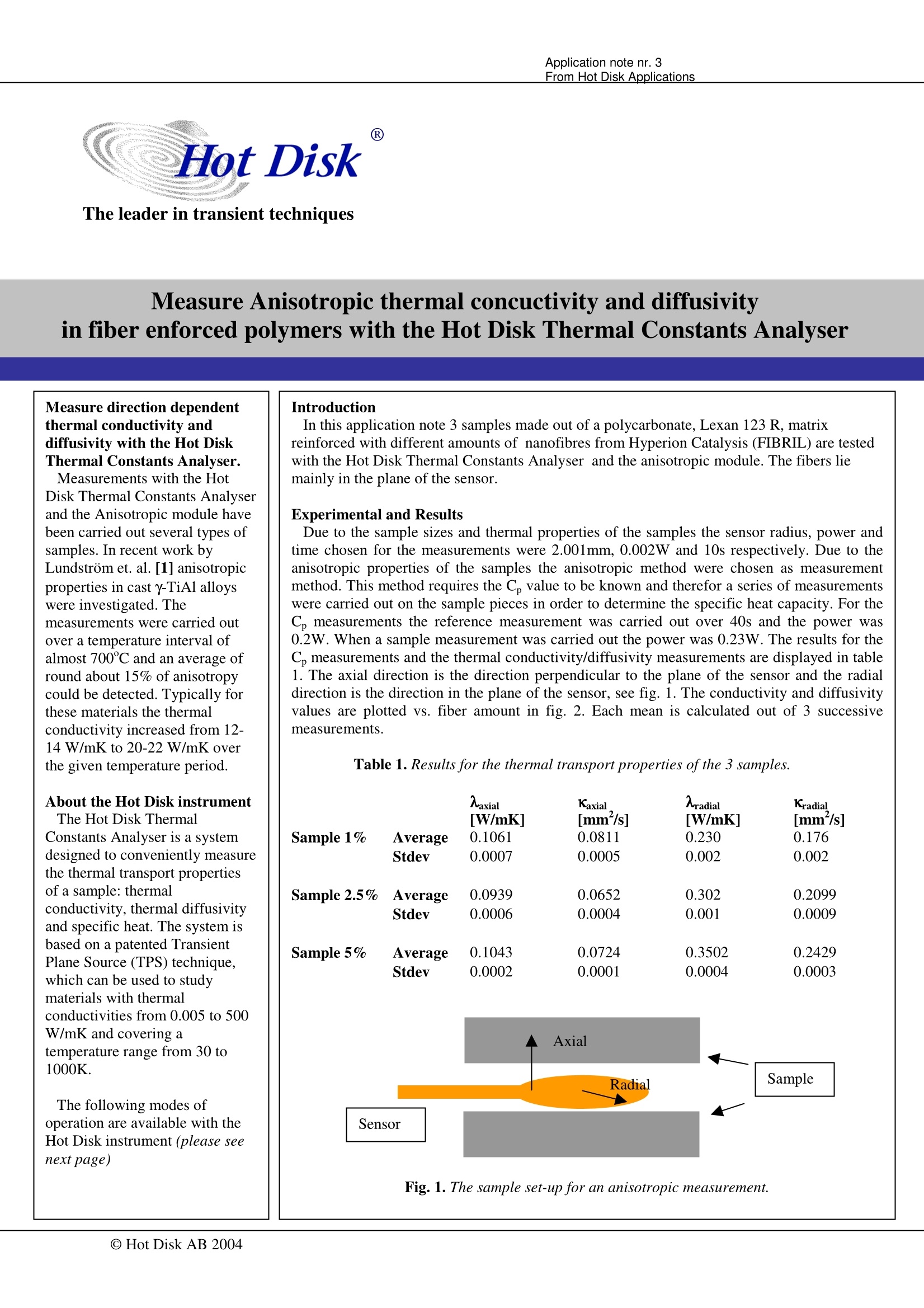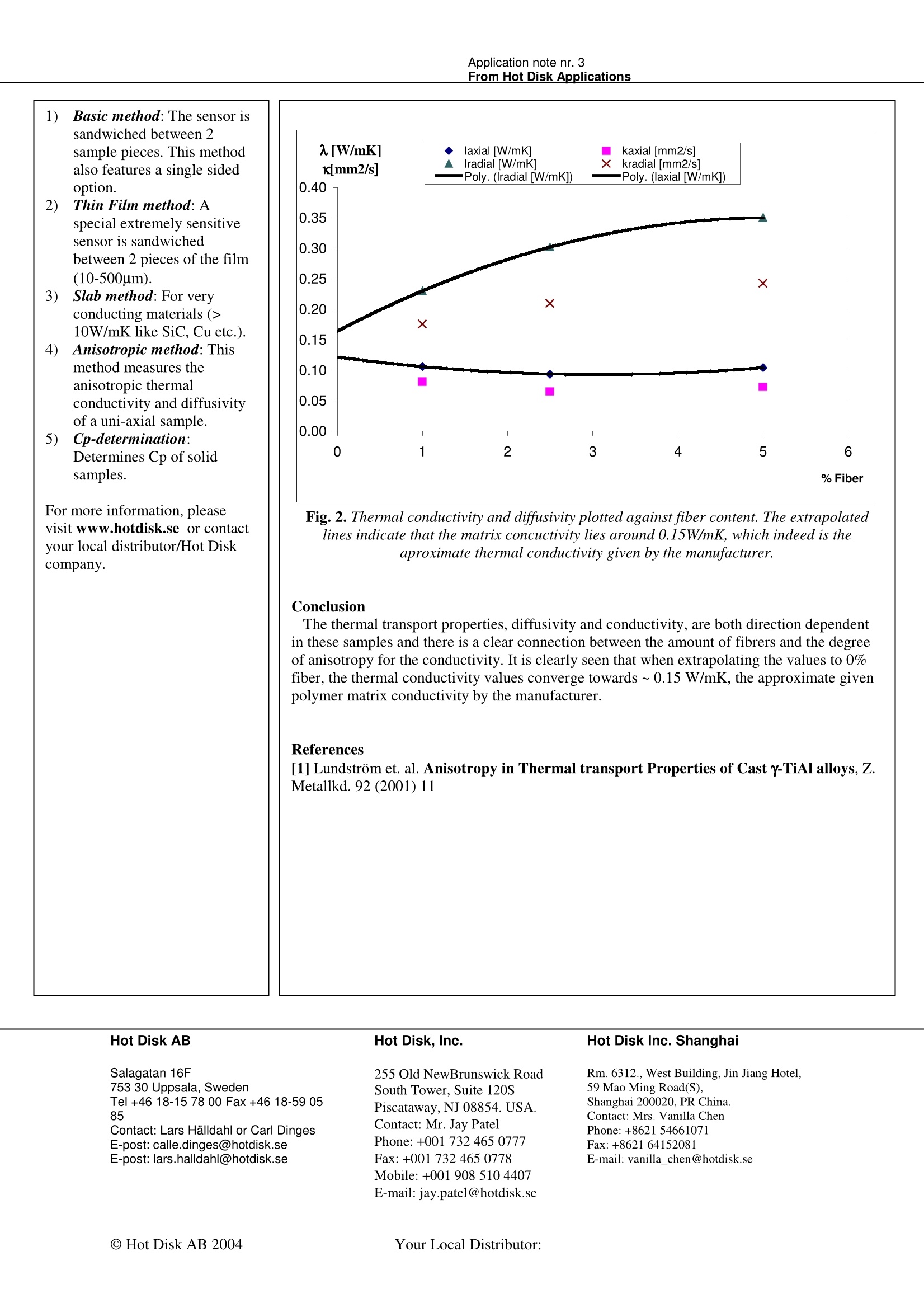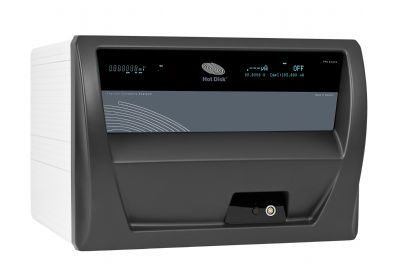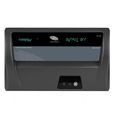方案详情
文
In this application note, samples made out of a polycarbonate, Lexan 123 R, matrix reinforced with different amounts of nanofibres from Hyperion Catalysis (FIBRIL) are tested with the Hot Disk Thermal Constants Analyser and the anisotropic module. The fibers lie
mainly in the plane of the sensor.
方案详情

Application note nr. 3From Hot Disk Applications Measure direction dependentthermal conductivity anddiffusivity with the Hot DiskThermal Constants Analyser.Measurements with the HotDisk Thermal Constants Analyserand the Anisotropic module havebeen carried out several types ofsamples. In recent work byLundstrom et. al.[1] anisotropicproperties in cast y-TiAl alloyswere investigated. Themeasurements were carried outover a temperature interval ofalmost 700℃ and an average ofround about 15% of anisotropycould be detected. Typically forthese materials the thermalconductivity increased from 12-14 W/mK to 20-22 W/mK overthe given temperature period. About the Hot Disk instrumentThe Hot Disk ThermalConstants Analyser is a systemdesigned to conveniently measurethe thermal transport propertiesof a sample: thermalconductivity, thermal diffusivityand specific heat. The system isbased on a patented TransientPlane Source (TPS) technique,which can be used to studymaterials with thermalconductivities from 0.005 to 500W/mK and covering atemperature range from 30 to1000K. The following modes ofoperation are available with theHot Disk instrument (please seenext page) Introduction In this application note 3 samples made out of a polycarbonate, Lexan 123 R, matrixreinforced with different amounts of nanofibres from Hyperion Catalysis (FIBRIL) are testedwith the Hot Disk Thermal Constants Analyser and the anisotropic module. The fibers liemainly in the plane of the sensor. Experimental and Results Due to the sample sizes and thermal properties of the samples the sensor radius, power andtime chosen for the measurements were 2.001mm, 0.002W and 10s respectively. Due to theanisotropic properties of the samples the anisotropic method were chosen as measurementmethod. This method requires the Cp value to be known and therefor a series of measurementswere carried out on the sample pieces in order to determine the specific heat capacity. For theCp measurements the reference measurement was carried out over 40s and the power was0.2W. When a sample measurement was carried out the power was 0.23W. The results for theCp measurements and the thermal conductivity/diffusivity measurements are displayed in table1. The axial direction is the direction perpendicular to the plane of the sensor and the radialdirection is the direction in the plane of the sensor, see fig. 1. The conductivity and diffusivityvalues are plotted vs. fiber amount in fig. 2. Each mean is calculated out of 3 successivemeasurements. Table 1. Results for the thermal transport properties of the 3 samples. Fig. 1. The sample set-up for an anisotropic measurement. 1)1Basic method: The sensor issandwiched between 2sample pieces. This methodalso features a single sidedoption. 2)Thin Film method: Aspecial extremely sensitivesensor is sandwichedbetween 2 pieces of the film(10-500um). 3)Slab method: For veryconducting materials (>10W/mK like SiC, Cu etc.). 4)Anisotropic method: Thismethod measures theanisotropic thermalconductivity and diffusivityof a uni-axial sample. 5)(Cp-determination:Determines Cp of solidsamples. For more information, pleasevisit www.hotdisk.se or contactyour local distributor/Hot Diskcompany. Fig.2. Thermal conductivity and diffusivity plotted against fiber content. The extrapolated lines indicate that the matrix concuctivity lies around 0.15W/mK, which indeed is the aproximate thermal conductivity given by the manufacturer. Conclusion The thermal transport properties, diffusivity and conductivity, are both direction dependent in these samples and there is a clear connection between the amount of fibrers and the degree of anisotropy for the conductivity. It is clearly seen that when extrapolating the values to 0% fiber, the thermal conductivity values converge towards~0.15 W/mK, the approximate given polymer matrix conductivity by the manufacturer. References [1] Lundstrom et. al. Anisotropy in Thermal transport Properties of Cast y-TiAl alloys, Z. Metallkd. 92 (2001) 11 Hot Disk AB Hot Disk, Inc. Hot Disk Inc. Shanghai 255 Old NewBrunswick Road Rm. 6312., West Building, Jin Jiang Hotel, 753 30 Uppsala, Sweden South Tower, Suite 120S 59 Mao Ming Road(S), Tel +46 18-15 7800 Fax+46 18-59 05 Shanghai 200020, PR China. 85 Contact: Mrs. Vanilla Chen Contact: Lars Halldahl or Carl Dinges Phone: +8621 54661071 E-post: calle.dinges@hotdisk.se E-post: lars.halldahl@hotdisk.se Fax: +8621 64152081 E-mail: vanilla chen@hotdisk.se E-mail: jay.patel@hotdisk.se C Hot Disk AB Salagatan Piscataway, NJ USA.Contact: Mr. Jay PatelPhone: +ax: +obile: + Hot Disk AB our Local Distributor:
确定


还剩1页未读,是否继续阅读?
凯戈纳斯仪器商贸(上海)有限公司为您提供《Hot Disk方法对纤维增强高聚物的导热性能的各向异性测试》,该方案主要用于纤维中--检测,参考标准--,《Hot Disk方法对纤维增强高聚物的导热性能的各向异性测试》用到的仪器有Hot Disk热常数分析仪、Hot Disk导热系数仪/Hot Disk 热常数分析仪
相关方案
更多











